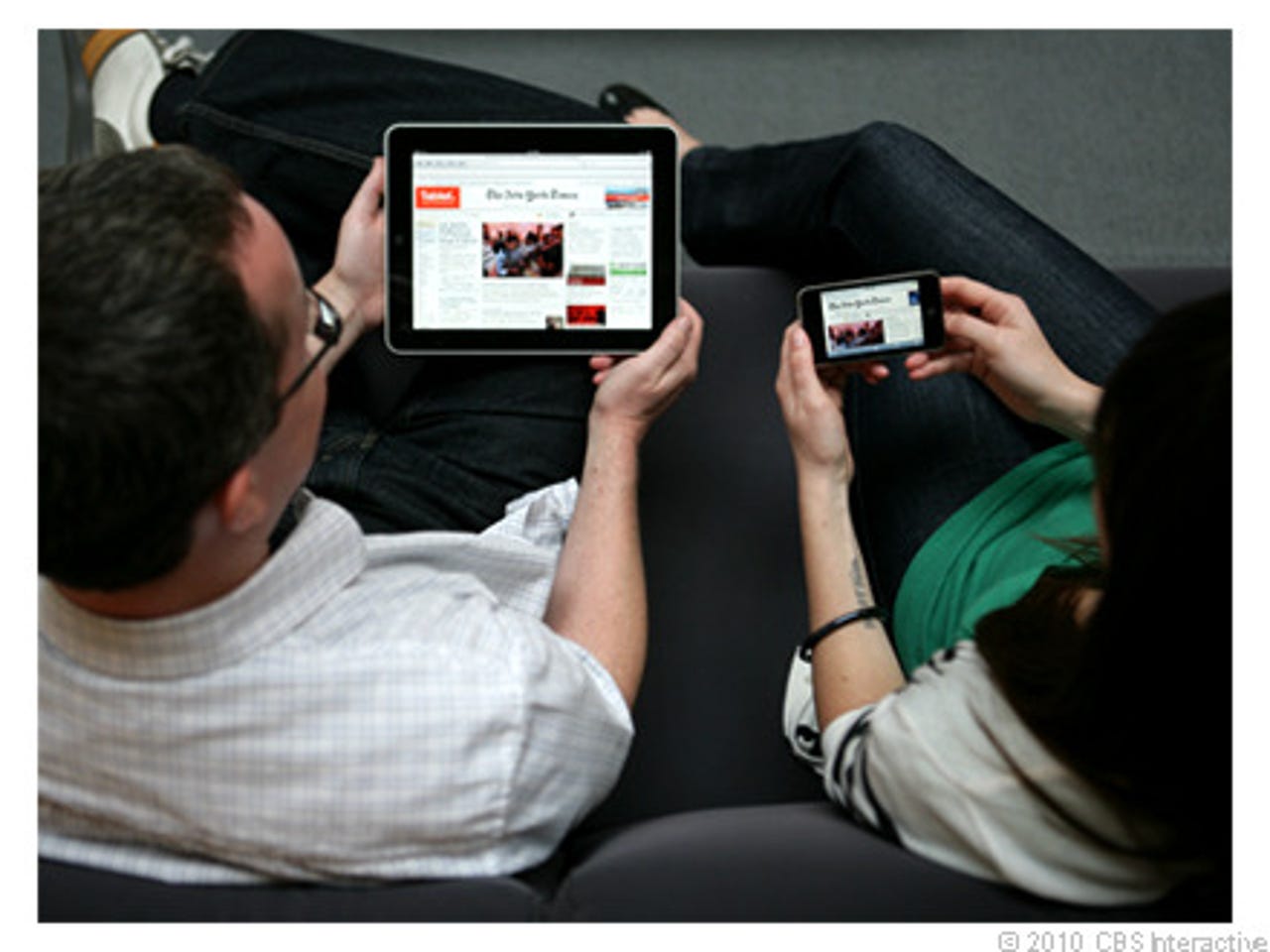iPhone's new OS, Nasa's supercomputers, latest BlackBerry and more


Photos of the month - April 2010
After its official unveiling back in January this year, the much-anticipated Apple iPad wi-fi-only version finally went on sale in the US at the beginning of this month.
The iPad is about six times larger than the iPhone, as seen above, and has already shifted a million units.
For a close up in the iPad from every angle, take a look at our photo story Apple's iPad tablet - it's finally here.
Photo credit: Josh P Miller/CNET
The iPad sold 300,000 devices on its launch day while one million apps were downloaded for the touchscreen tablet.
Last month, silicon.com featured a selection of the software available for the device such as the Twitterific app, pictured above.
You can take a look at more of the top iPad apps in the full story here.
Photo credit: Nicole Lee/CNET
And it wasn't just the iPad that saw Apple making the headlines last month: the company's CEO Steve Jobs took to the stage at a US media event in April to announce the iPhone OS 4.0.
The upgrades to the operating system include multitasking, background audio, background location, voice over IP, a new folders feature and the introduction of the iAd mobile advertising platform.
The update will arrive this summer.
For more from the event and what users can expect from iPhone 4.0, see the full story here.
Photo credit: James Martin/CNET
BlackBerry-maker RIM was also busy last month, announcing its smallest ever BlackBerry handset: the Pearl 3G (pictured above).
The diminutive Pearl 9100 is aimed at mobile users who are "new to the smartphone market", according to a RIM spokesman, and likely to be using a feature phone at present.
Follow this link to see more pictures of the 3G Pearl - and RIM's refresh of its Bold handset.
Photo credit: RIM
April saw Microsoft join RIM in unveiling a duo of new phones.
The Kin One and Two are targeted at social networking fanatics, and bring together Facebook, MySpace and Twitter all on the Kin homescreen, dubbed the Kin Loop.
Both phones feature a touchscreen and slideout Qwerty keypad. Pictured above is the Kin Two with its slideout physical keyboard visible and Facebook update screen.
For more from the Kin, see the full photo story here.
Photo credit: James Martin/CNET News.com
From cutting-edge mobile kit to a veritable technology antique - the Nokia 3210 (pictured above) may have been released in the late 1990s but the humble talk-and-text handset came second in a poll of the nation's favourite mobile devices, conducted by the University of Salford.
The 3210 was one of five Nokia handsets in the top 10 - but before you ask, the nation's number one handset is much more modern: the Apple iPhone.
Follow this link to see the full top 10 list of Brits' most iconic mobiles.
Photo credit: Nokia
Other antiques to feature on silicon.com this month include this digital recreation of a 9,000-year-old Neolithic building in Turkey, created using the University of Southampton's Iridis 3 supercomputer, the most powerful supercomputer owned and operated by a UK university.
The image was created using 3D geo-dimensional physics data through a collaboration between the University of Southampton and Stanford University in the US.
See how other departments within the university - as well as paying customers - are using Iridis 3's computing power to further research here.
Photo credit: Dr Graeme Earl
silicon.com also took a look at the advanced supercomputing facility of Nasa last month.
The facility, at its Ames Research Center in California, houses Pleiades which at a current measurement of 973 teraflops - or 973 trillion floating point operations per second - is the sixth most powerful computer in the world.
Pleiades is used by Nasa staff for research in earth and space sciences, and for conducting giant simulations. The machine is almost fully subscribed - meaning it's in use 24 hours per day, seven days per week.
Pictured above is a look inside one of the 32 Altix ICE 8400 racks that are part of the Pleiades supercomputer.
Click here for more from Nasa's supercomputing facility.
Photo credit: Daniel Terdiman/CNET
The technology that carried man and machines into space is finding a second lease of life in factories, planes and everyday items around the home.
In April the European Space Agency showed off some of the space-based technologies that have been successfully transferred into the everyday world at the 2010 Hanover Fair.
One such tech is software, called Simpack, that has been used to help design the International Space Station, seen here.
Blast off and discover more cosmic tech that has come back down to earth here.
Photo credit: Nasa
Last month also featured more tech in extreme conditions courtesy of the Catlin Arctic Survey.
The survey was in the Canadian high Arctic in April, studying changes in ocean acidity and ice thickness in the Arctic Ocean. The team relies heavily on technology to carry out its work and communicate with the team back in the UK, much of which the explorer team transports on sledges dragged across the ice.
Pictured above is a member of the team using a conductivity, temperature and depth (CTD) profiler to gather data from water. Check out the full story here to see what other technology the team used.
Photo credit: Martin Hartley
The US's inaugural National Robotics Week also took place last month. Stanford University hosted a Robot Block Party in the week, where locals could showcase cutting edge robotics technology and their own personal projects, including robots that drive cars, climb walls and help perform medical procedures.
This robotic arm, pictured above, is used primarily in lab research and is being applied to healthcare uses in hospitals. The arm incorporates seven degrees of freedom, using seven joints that provide very real and agile movements.
See more from the robot party in the full photo story here.
Photo credit: James Martin/CNET
The colourful future of data and statistics was brought to life at an event in London during April.
The event showcased how software is being used to present information in ways that makes it both interesting and instantly understandable.
One of the apps being shown off was Chromaroma, a game that allows London commuters to score points during their daily journey and to track the routes they have travelled using colourful visualisations of the capital's tube network.
Here you can see Chromaroma's representation of the routes that different teams of commuters - represented by different coloured lines - have travelled on London's tube network.
Delve deeper into more kaleidoscopic data here.
Photo credit: Chromaroma
Another notable event from April was Facebook's F8 developers conference in San Francisco.
The conference saw Facebook CEO Mark Zuckerberg announce Open Graph - an initiative designed to simplify the integration of social actions into other websites.
In the middle of the conference's exhibition centre was Hacker Central, shown here, where developers exchanged ideas with other hackers and Facebook employees.
For more from F8, see the full story here.
Photo credit: James Martin/CNET
More software debuts came in the form of Norton security products, Norton AntiVirus and Norton Internet Security, which were released to public beta last month.
The new Reputation scan, shown above, allows users to focus their security scan solely on the 'reputations' of existing files on their system.
See more screenshots from Norton's new software here.
Screenshot: Seth Rosenblatt/CNET
Microsoft's Windows Intune service, which also went into beta last month, offers a Silverlight-based web console to help midsize businesses to manage their PCs. The product is aimed at businesses under 500 seats trying to manage their machines with a small IT staff.
Pictured in the screen above, Intune can offer details on each PC a company has, including hardware details such as the processor speed and amount of memory, as well as information on which software - and which versions - are installed.
For more screenshots, see the full story on Intune here.
Photo credit: Microsoft
The latest feature film from DreamWorks Animation studio, How to Train Your Dragon, hit big screens recently. The studio turned to HP to provide the significant amount of computing power needed to make produce the film in 3D.
In order to finetune details of complex effects including fire-breathing dragons, waves and forests, DreamWorks used HP's Halo telepresence technology to help its teams work together.
Check out the full story to find out how else DreamWorks used the HP tech.
Image credit: How to Train Your Dragon and DreamWorks Animation
Retro tech was on the mind of ISP Virgin Media last month, which commissioned a laser lightshow called The Speed of Light to celebrate a decade of broadband connectivity in the UK.
Click here to see more from The Speed of Light.
Photo credit: Chris Beaumont/CBS Interactive
Broadband-provider TalkTalk was also getting flashy in April - opening a customer experience centre in Soho offering free internet and connectivity expertise in a central London location.
Its web hub also offers bookable lounge space for TalkTalk customers, and the rest of the building is given over to office space for web start-ups.
You can take a virtual tour of the new TalkTalk centre in this photo story.
Photo credit: Natasha Lomas/silicon.com
From one web hub to another: Bangalore, India's chief outsourcing centre.
The city took a big hit last year when the global financial downturn bit deep. But as economies recover worldwide, things are looking up and evidence of a gradual improvement in the US, which accounts for two-thirds of India's outsourcing revenues, is having an impact on Bangalore.
Pictured above is a series of advertising billboards on a busy street in downtown. The advertising reflects the upturn in the economy, as analysts predict growth in IT spending in key Western markets and a corresponding boost in demand for technology outsourced from Bangalore.
For more pictures from Bangalore, see the full story here.
Photo credit: Saritha Rai/silicon.com